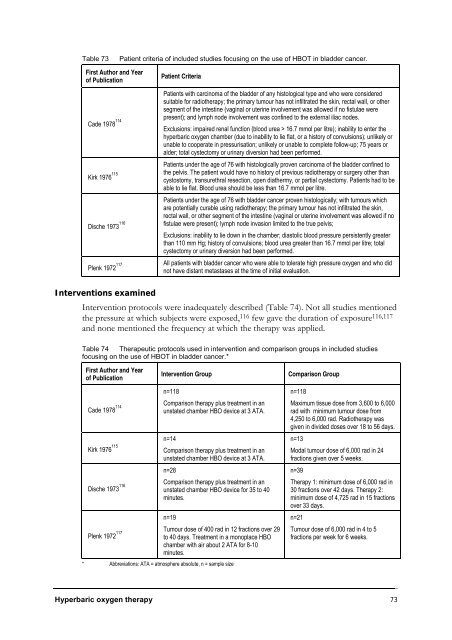Hyperbaric Oxygen Therapy - Hyperbaric Chamber Information ...
Hyperbaric Oxygen Therapy - Hyperbaric Chamber Information ...
Hyperbaric Oxygen Therapy - Hyperbaric Chamber Information ...
Create successful ePaper yourself
Turn your PDF publications into a flip-book with our unique Google optimized e-Paper software.
Table 73 Patient criteria of included studies focusing on the use of HBOT in bladder cancer.<br />
First Author and Year<br />
of Publication<br />
Cade 1978 114<br />
Kirk 1976 115<br />
Dische 1973 116<br />
Plenk 1972 117<br />
Patient Criteria<br />
Patients with carcinoma of the bladder of any histological type and who were considered<br />
suitable for radiotherapy; the primary tumour has not infiltrated the skin, rectal wall, or other<br />
segment of the intestine (vaginal or uterine involvement was allowed if no fistulae were<br />
present); and lymph node involvement was confined to the external iliac nodes.<br />
Exclusions: impaired renal function (blood urea > 16.7 mmol per litre); inability to enter the<br />
hyperbaric oxygen chamber (due to inability to lie flat, or a history of convulsions); unlikely or<br />
unable to cooperate in pressurisation; unlikely or unable to complete follow-up; 75 years or<br />
alder; total cystectomy or urinary diversion had been performed.<br />
Patients under the age of 76 with histologically proven carcinoma of the bladder confined to<br />
the pelvis. The patient would have no history of previous radiotherapy or surgery other than<br />
cystostomy, transurethral resection, open diathermy, or partial cystectomy. Patients had to be<br />
able to lie flat. Blood urea should be less than 16.7 mmol per litre.<br />
Patients under the age of 76 with bladder cancer proven histologically; with tumours which<br />
are potentially curable using radiotherapy; the primary tumour has not infiltrated the skin,<br />
rectal wall, or other segment of the intestine (vaginal or uterine involvement was allowed if no<br />
fistulae were present); lymph node invasion limited to the true pelvis;<br />
Exclusions: inability to lie down in the chamber; diastolic blood pressure persistently greater<br />
than 110 mm Hg; history of convulsions; blood urea greater than 16.7 mmol per litre; total<br />
cystectomy or urinary diversion had been performed.<br />
All patients with bladder cancer who were able to tolerate high pressure oxygen and who did<br />
not have distant metastases at the time of initial evaluation.<br />
Interventions examined<br />
Intervention protocols were inadequately described (Table 74). Not all studies mentioned<br />
the pressure at which subjects were exposed, 116 few gave the duration of exposure116,117 and none mentioned the frequency at which the therapy was applied.<br />
Table 74 Therapeutic protocols used in intervention and comparison groups in included studies<br />
focusing on the use of HBOT in bladder cancer.*<br />
First Author and Year<br />
of Publication<br />
Cade 1978 114<br />
Kirk 1976 115<br />
Dische 1973 116<br />
Plenk 1972 117<br />
Intervention Group Comparison Group<br />
n=118<br />
Comparison therapy plus treatment in an<br />
unstated chamber HBO device at 3 ATA.<br />
n=14<br />
Comparison therapy plus treatment in an<br />
unstated chamber HBO device at 3 ATA.<br />
n=28<br />
Comparison therapy plus treatment in an<br />
unstated chamber HBO device for 35 to 40<br />
minutes.<br />
n=19<br />
Tumour dose of 400 rad in 12 fractions over 29<br />
to 40 days. Treatment in a monoplace HBO<br />
chamber with air about 2 ATA for 8-10<br />
minutes.<br />
* Abbreviations: ATA = atmosphere absolute, n = sample size<br />
n=118<br />
Maximum tissue dose from 3,600 to 6,000<br />
rad with minimum tumour dose from<br />
4,250 to 6,000 rad. Radiotherapy was<br />
given in divided doses over 18 to 56 days.<br />
n=13<br />
Modal tumour dose of 6,000 rad in 24<br />
fractions given over 5 weeks.<br />
n=39<br />
<strong>Therapy</strong> 1: minimum dose of 6,000 rad in<br />
30 fractions over 42 days. <strong>Therapy</strong> 2:<br />
minimum dose of 4,725 rad in 15 fractions<br />
over 33 days.<br />
n=21<br />
Tumour dose of 6,000 rad in 4 to 5<br />
fractions per week for 6 weeks.<br />
<strong>Hyperbaric</strong> oxygen therapy 73



